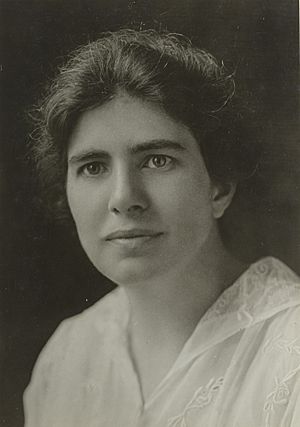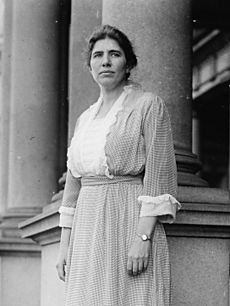Hannah J. Patterson facts for kids
Quick facts for kids
Hannah J. Patterson
|
|
|---|---|

Patterson in 1918
|
|
| Born |
Hannah Jane Patterson
November 5, 1879 |
| Died | August 21, 1937 (aged 57) Pittsburgh, Pennsylvania, US
|
| Education | Wilson College (A.B.) Columbia University University of Pennsylvania |
| Occupation | Suffragist |
| Awards | Distinguished Service Medal |
Hannah Jane Patterson (born November 5, 1879 – died August 21, 1937) was an important American activist. She worked hard for women's right to vote, also known as women's suffrage. She was a key leader in Pennsylvania's suffrage movement. Patterson also helped the National American Woman Suffrage Association (NAWSA). During World War I, she served on the Woman's Committee of the Council of National Defense. For her great service, she received the Distinguished Service Medal. Patterson studied at Wilson College, Columbia University, and the University of Pennsylvania.
Contents
Early Life and Education
Hannah Jane Patterson was born on November 5, 1879. Her hometown was Smithton, Pennsylvania. Her parents were Harriet McCune and John Gilfillan Patterson. Her father was a banker.
In 1897, Hannah began her studies at Wilson College. This college is in Chambersburg. At first, she missed home. But she soon joined many activities. She played baseball, field hockey, tennis, and basketball. She was also on the debate team. Hannah was even elected class president. She earned her college degree, a A.B., in 1901.
After Wilson College, Patterson continued her education. In 1902, she went to Columbia University. There, she took classes about finance. She also studied law at the University of Pennsylvania.
Working for Change and Women's Rights
Hannah Patterson was a well-educated woman. She lived during the Progressive Era. This was a time when many people wanted to improve society. Patterson joined groups that worked for important changes. These changes included new laws for child labor. She also fought for women's rights and better public health laws.
After moving to Pittsburgh, Patterson joined the Civic Club of Allegheny County. She helped create a special juvenile court for young people in the county. In 1904, she started the Allegheny County Equal Rights Association. She founded it with Jennie Bradley Roessing, Mary Bakewell, Mary Flinn, and Lucy and Eliza Kennedy.
Their group created the "Pittsburgh Plan." This plan suggested making local groups for women's voting rights. These groups would be at the political precinct level. The National American Woman Suffrage Association (NAWSA) later used this plan across the country.
Patterson also worked with the Allegheny County Committee on School Legislation. She was part of the Consumers' League of Western Pennsylvania. She always supported Wilson College. In 1906, the college's Alumnae Association chose her as their treasurer. Later, she became the president of the association. She also became one of the college's trustees.
Fighting for Women's Vote
By 1910, Hannah Patterson was actively campaigning for women's right to vote. She was a very important leader in the Pennsylvania suffrage movement. She served as vice president of the Pennsylvania Woman Suffrage Association (PWSA). She was also the first person to lead Pennsylvania's Woman Suffrage Party. She held this position until 1915.

In November 1914, Patterson gave a speech in Scranton. This was at the 46th yearly meeting of the Pennsylvania Woman Suffrage Association. The Evening Ledger newspaper in Philadelphia said she was "one of the most convincing speakers for the cause."
"Manmade laws down the ages have been framed to protect property, including woman herself as a chattel; the modern woman wants them framed to protect life, to protect children in the schools and from factories, to raise the age of consent, to give us food free from adulteration… The great importance of this question lies in the fact that, deprived of the vote, women are cut off from the most important field of human activity."
—Patterson, speaking at the Pennsylvania Woman Suffrage Association convention
In 1915, Patterson and PWSA president Roessing led a big effort. They wanted to change the Pennsylvania Constitution. This change would allow all women to vote. They worked very hard, attending public events and giving speeches. They traveled all over the state.
The PWSA also ordered the creation of the Justice Bell. This bell was a copy of the Liberty Bell. Its clapper was chained to its side. This showed how women were being silenced by not having the right to vote. Patterson joined the bell's tour. It traveled to every county in Pennsylvania. On July 7, 1915, Patterson even threw out the first pitch. This was at a "Suffrage Day" baseball game. The Phillies played against the Giants.
Even though the suffrage amendment was not passed, their hard work made a difference. The main political parties started to include women's suffrage in their plans for 1916.
After this, Patterson moved to New York City. In 1916, she was chosen to be the corresponding secretary for NAWSA.
World War I Service
In April 1917, the United States joined World War I. Hannah Patterson was then chosen to be part of the Woman's Committee of the Council of National Defense. The Committee elected her as the Resident Director of their main office. She managed 15 women who worked in Washington, D.C. Their office was called "the Little Playhouse."
The next year, she became the Associate Director of the new Field Division. She also joined its governing board. As Resident Director, Patterson was in charge of all the committee's departments. The Committee helped state groups work together for the war effort. It also connected the government with women's groups in all 48 states.
The President of the United States of America, authorized by Act of Congress, July 9, 1918, takes pleasure in presenting the Army Distinguished Service Medal to Hannah J. Patterson, a United States Civilian, for exceptionally meritorious and distinguished services to the Government of the United States, in a duty of great responsibility during World War I. Hannah Paterson devoted herself through the whole period of the war to executive work of the Women's Committee of the Council of National Defense, devoting herself with great ability and energy to the organization of the activities and interests of the women throughout the United States in the interest of the successful prosecution of the war and, by her efforts, contributed to the splendid cooperation on the part of the women of the country in the great national emergency.
In 1919, Patterson received the Army's Distinguished Service Medal. This was for her service during the war. She was one of the first civilian women to get this award. At that time, it was the highest non-combat award from the U.S. government.
After the war, she became an assistant to Newton D. Baker. He was the Secretary of War for President Woodrow Wilson. Patterson also served on the War Risk Advisory Committee. She worked with Charles Evans Hughes, who later became a Chief Justice.
Later Life and Legacy
After the war, Patterson went back to Pittsburgh. In the 1920s, she became an investment advisor. She led the women's department at J. H. Holmes & Co., a brokerage firm. She also served on the board of directors for the bank her father ran in West Newton.
In 1931, Patterson helped her friend Sara Soffel. She managed Soffel's successful campaign to become a judge. Soffel became Pennsylvania's first woman judge. In 1935, Patterson was asked to run for Congress. But she decided not to.
Hannah Patterson passed away on August 21, 1937. She died at West Penn Hospital in Pittsburgh. She is buried at West Newton Cemetery. Patterson never married and did not have any children.
Images for kids



